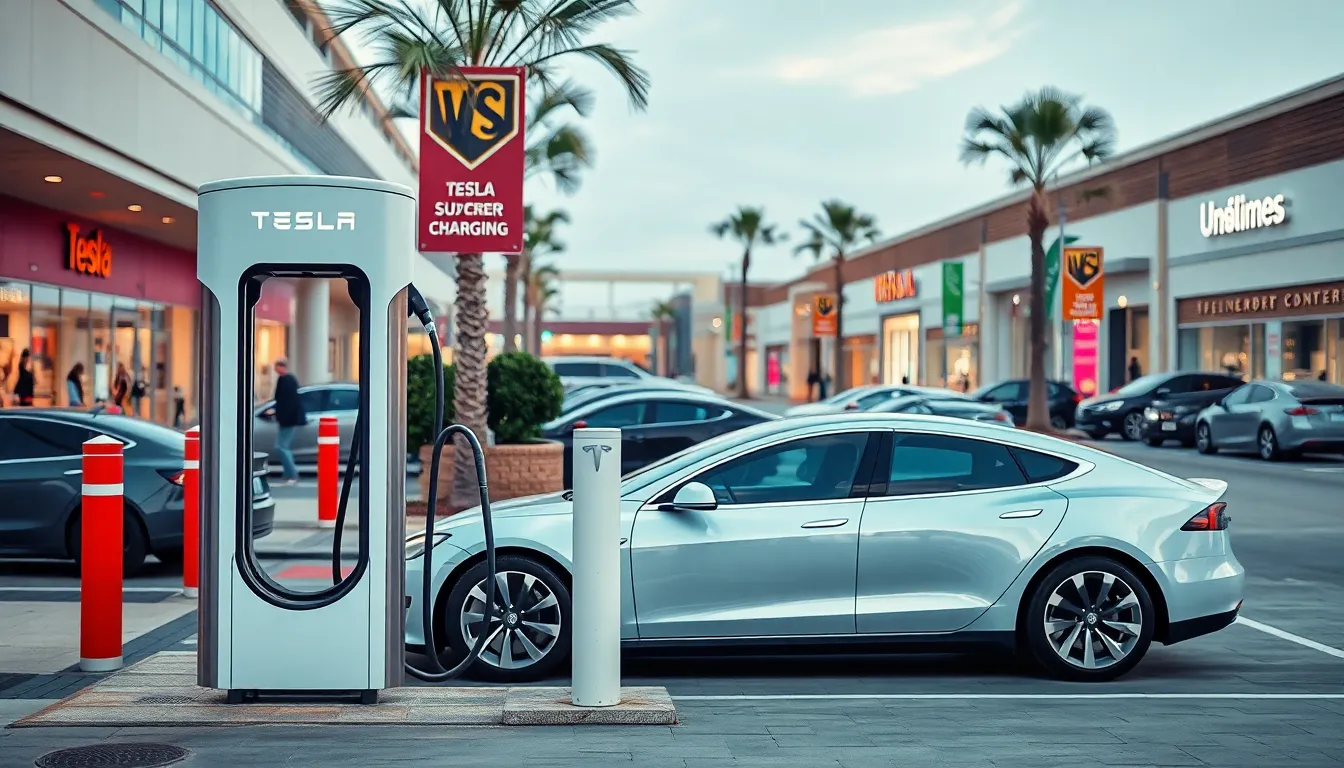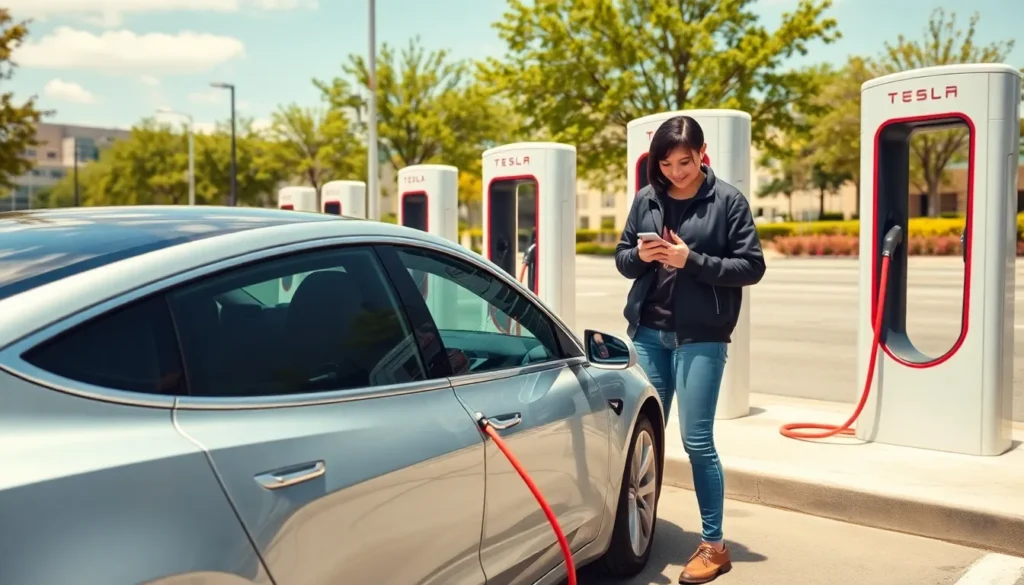Table of Contents
ToggleAs electric vehicles zoom into the mainstream, Tesla owners often find themselves pondering a burning question: is it really free to charge a Tesla? Imagine cruising into a charging station, sipping your coffee, and watching your car fill up like a kid at an all-you-can-eat buffet. Sounds dreamy, right? But hold your horses—there’s more to it than meets the eye.
While some charging options might leave your wallet unscathed, others could have you digging deep. With a mix of free supercharging, subscription models, and pay-per-use stations, navigating Tesla’s charging landscape can feel like a game of Monopoly. So, buckle up as we dive into the electrifying world of Tesla charging costs and discover if you can truly charge for free or if you’ll need to cough up some cash.
Overview of Tesla Charging Options
Tesla owners benefit from several charging options tailored to different needs. Home charging offers convenience, using a standard electrical outlet or a Tesla Wall Connector, allowing charging overnight. Superchargers provide extensive coverage for long-distance travel, enabling rapid charging in about 30 to 40 minutes.
Public charging stations present an alternative for those away from home. Many third-party networks charge per kilowatt-hour, which varies by location. Charging at these stations can sometimes lead to unexpected costs, depending on the provider.
Tesla also offers free supercharging with specific vehicle purchases or promotions. Some owners, however, may find that these offers end after a specified duration or mileage. Subscription-based models exist for those seeking access to unlimited supercharging, which appeals to frequent travelers or commuters.
The cost of charging varies among options. Owners might find that charging at home yields savings compared to public stations. According to the U.S. Department of Energy, charging an electric vehicle costs about half as much per mile compared to gasoline vehicles.
Understanding the different charging solutions helps Tesla owners optimize their costs and charging strategies. The choice of charging method significantly influences the overall experience and expenses associated with owning a Tesla. Each option brings unique benefits but can also entail additional costs depending on usage.
Public Charging Stations

Public charging stations play a significant role in Tesla’s charging ecosystem. They offer Tesla owners access to electricity when away from home.
Types of Charging Stations
Numerous types of charging stations exist, including Level 2 chargers and fast DC chargers. Level 2 chargers deliver charging at 240 volts, providing a slower but more accessible option for destinations like shopping centers and restaurants. Fast DC chargers, often found in public locations, deliver power quickly, making them ideal for road trips. Tesla’s Supercharger network represents one of the fastest charging options, allowing drivers to recharge their vehicles in under an hour. Each charging type serves various needs, from long-distance travel to daily commuting.
Pricing Structures
Pricing structures at public charging stations frequently vary. Many stations charge users per kilowatt-hour consumed, which can lead to fluctuating costs depending on energy prices. Some locations also implement time-based fees, charging users for the duration spent connected to the charger. Tesla Superchargers typically follow a pay-per-use basis, with fees varying by location. In certain cases, Tesla owners might find complimentary charging options as promotions or incentives tied to particular vehicles. Evaluating these costs helps users determine their most economical charging strategy while utilizing public stations.
Home Charging Solutions
Home charging provides Tesla owners with a convenient and cost-effective way to keep their vehicles charged. Understanding installation costs and electricity rates is vital for assessing overall expenses.
Installation Costs
Installing a home charging station incurs initial costs. On average, professional installation ranges from $500 to $1,500 depending on the electrician’s fees and local permits. Tesla’s Wall Connector offers the fastest charging option for home use. Homeowners may also need to upgrade their electrical panel for optimal charging speeds, which can add $1,000 or more to the total cost. Investing in a home charging solution saves time compared to frequent visits to public charging stations.
Electricity Rates
Electricity rates significantly influence the overall cost of charging a Tesla at home. Average residential rates in the U.S. typically range from $0.10 to $0.25 per kilowatt-hour. Charging at off-peak hours can lower costs significantly since many utility companies offer time-of-use plans. For instance, charging overnight could save Tesla owners as much as 50% on their electricity bills. Knowing local electricity rates helps estimate monthly charging expenses effectively.
Free Charging Opportunities
Tesla owners can take advantage of certain promotions and incentives that offer free charging options. Limited-time offers often accompany vehicle purchases, granting complimentary supercharging for a specified duration. Some new Tesla models come with free supercharging, but these promotions may not be available indefinitely. Availability can vary based on region and time of purchase, so careful consideration is essential.
Promotions and Incentives
Tesla frequently introduces promotions aimed at boosting sales and enhancing customer satisfaction. These promotions can include free supercharging for a set period or specific mileage limits. Seasonal offers may arise, encouraging potential buyers to explore electric vehicles. Customers interested in maximizing their charging opportunities should keep an eye on Tesla’s announcements and website.
Charging Networks Offering Free Access
Certain charging networks provide free access to their stations, benefiting Tesla owners. Popular platforms like ChargePoint and EVgo occasionally have free charging events or partnerships with businesses. Restaurants, shopping centers, or hotels may offer complimentary charging as a customer perk, creating convenient options for drivers. Local municipalities sometimes establish free public charging stations to promote electric vehicle adoption, ensuring availability in various locations. Staying informed about these opportunities can significantly reduce charging costs.
Charging a Tesla isn’t as straightforward as it may seem. While free supercharging options exist, they often come with restrictions and may not apply to every vehicle. Home charging offers convenience and can be cost-effective, but installation and electricity rates can impact overall expenses. Public charging stations provide necessary support for long trips, yet they typically operate on a pay-per-use basis, which can lead to unexpected costs.
By understanding the various charging options and their associated fees, Tesla owners can make informed decisions that align with their driving habits and budget. Staying updated on promotions and incentives can further enhance the charging experience, making it easier to manage costs effectively.



